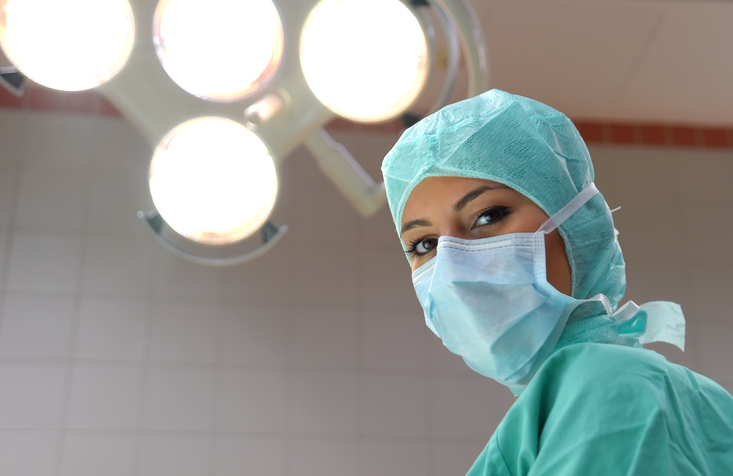An N95 respirator is a respiratory protective device designed to achieve a very close facial fit and very efficient filtration of airborne particles. The ‘N95’ designation means that when subjected to careful testing, the respirator blocks at least 95 percent of very small (0.3 micron) test particles. There are also N99 and N100 respirators (N100s stop at least 99.97% of particles from entering) (1). Legitimate surgical respirators must be approved by both the FDA and the NIOSH (the National Institute for Occupational Safety and Health). Some N95s feature exhalation valves, which help the wearer to breathe more easily. It is important to note that not all N95 respirators are designed for medical applications; some are manufactured for industrial use. Medical N95s are single-use products regulated as class II products under the FDA and NIOSH (1). Although the demand for N95s has greatly increased during the current coronavirus (COVID-19) pandemic, the CDC recommends that N95 masks must continue to be reserved for health care workers and other medical first responders (2). For members of the general public, the CDC recommends the use of simple cloth face coverings when in a public setting to slow the spread of the virus (2).
An N95 respirator consists of multiple layers of nonwoven fabric, often made from polypropylene. The two outward protective layers of fabric, covering the inside and outside of the mask, are between 20 and 50 g/m2 in density and act as protection against the outside environment, as well as a barrier to anything in the wearer’s exhalations (1). Between the two aforementioned ‘outer’ layers is a pre-filtration layer, which can be as dense as 250 g/m2, and the filtration layer. The pre-filtration layer is usually needled, nonwoven fabric. Needled nonwoven material is created by sending barbed needles repeatedly through the fabric to hook fibers together, in order to increase the cohesiveness of the material. The pre-filtration layer is then run through a hot calendering process, in which plastic fibers are thermally bonded by running them through high pressure heated rolls. This makes the pre-filtration layer thicker and stiffer, so it can be molded to form the desired shape and stay in that shape as the mask is used (1). The last layer is a high efficiency, melt-blown, polarized nonwoven material, which determines the filtration efficiency. Meltblowing is a process in which multiple machine nozzles use air to spray threads of melted synthetic polymers onto a conveyor. As the conveyor continues, the threads build up and bond by themselves as they cool, thereby creating the fabric. Sometimes, melt-blown fabric is also thermally bonded to add strength and abrasion resistance, although the material then begins to lose some of its fabric characteristics (1). The full respirators are made through converting machinery, which combines the layers through ultrasonic welding and adds straps and metal strips to adjust the mask over the user’s nose. The respirators are then sterilized as a last step before being shipped (1).
On April 3, drastic shortages of N95 masks led the FDA to allow imports of similar masks from China. These masks, known as KN95, were never tested by American regulators, but were required to be vetted by an accredited test laboratory, which could be outside the United States, showing that they met the standards of the CDC. As an additional safeguard, the CDC and the FDA initiated their own review to make sure the masks met these performance standards. In tests of about 11 masks that the FDA had authorized to be sold to American hospitals, seven flunked (3). One mask removed as little as 24 to 35 percent of particles, according to a CDC test on April 15. Others just barely missed the cut, such as masks from DaddyBaby, a company in Fuzhou, China, that typically makes diapers. Those masks removed between 91 percent and 93.5 percent of particles. The health agencies also tested some KN95 masks that did not have agency approval. One of these, the F.D.A. said, blocked roughly 1 percent of the particles. On May 7, the FDA barred more than 65 of 80 previously authorized manufacturers in China from exporting these KN95 masks to the United States for medical use (3).
Nevertheless, there is no need to worry about the availability of N95 masks in the US, as both Honeywell and 3M have promised to ramp up their production of these vital respirators. As of March 23, 3M has doubled its global production of N95 masks to about 100 million a month, and is planning to invest in new equipment to push annual mask production to 2 billion within 12 months (4). On March 22, Chief Executive Officer Mike Roman said in a news release that 3M had sent 500,000 respirators to hard-hit Seattle and New York City, and that it was ramping up production of hand sanitizers and disinfectants as well. Two days later, Roman said 3M would work with Ford Motor Co. to produce powered air purifying respirators, waist-mounted devices that blow air into helmets that shield wearers. Honeywell is also increasing N95 production, saying it will hire at least 500 people to expand capacity at a facility in Rhode Island (4).
References
- Henneberry, B. (n.d.). How to Make N95 Masks. Retrieved from https://www.thomasnet.com/articles/plant-facility-equipment/how-to-make-n95-masks/
- Center for Devices and Radiological Health. (n.d.). N95 Respirators and Surgical Masks (Face Masks). Retrieved from https://www.fda.gov/medical-devices/personal-protective-equipment-infection-control/n95-respirators-and-surgical-masks-face-masks#s3
- Nicas, J., & Kaplan, S. (2020, May 7). F.D.A. Bans Faulty Masks, 3 Weeks After Failed Tests. Retrieved from https://www.nytimes.com/2020/05/07/health/masks-banned-n95-coronavirus.html
- Gruley, B., & Clough, R. (2020, March 25). How 3M Plans to Make More Than a Billion Masks By End of Year. Retrieved from https://www.bloomberg.com/news/features/2020-03-25/3m-doubled-production-of-n95-face-masks-to-fight-coronavirus
